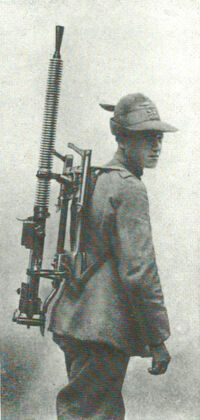The Mitragliatrice Leggera SIA Modello 1918 was an Italian air-cooled light machine gun[1] designed by Giovanni Agnelli in 1914 and produced by Società Italiana Aviazione from 1918 to 1923.
History[]
In approximately 1915 or 1916, the Villar Perosa was introduced into service, laying the foundation of certain new combat techniques and was suitable enough to be adopted by the Arditi. However, problems were found with the Villar Perosa, owing to its unique construction.
In 1918, RIV proposed a design of machine gun chambered in 6.5mm Carcano to the Royal Italian Army, and designed a prototype machine gun for that purpose which was submitted for testing. The first prototype of this design was rejected, with RIV asked to make improvements to the weapon, mainly involving the shortening of its barrel and other minor changes. The next prototype incorporated the improvements recommended by the Royal Italian Army was taken into service, with production allocated to Società Italiana Aviazione (SIA).[1]
The SIA was meant to be armed by small combat units for ambushes, but was most notably used as a mounted machine gun mounted on aircraft and some light tanks like the FIAT 3000; the machine gun was apparently a popular choice for use on tanks.[2] The SIA was meant to be distributed evenly amongst companies, with each company receiving eight SIAs with two SIAs being used by each platoon.
Production ended in 1923 after about 18,000 were produced. It is alleged that the weapon was used up until at least 1943 when it was distributed to rearmost troops, coastal battalions and the Blackshirts. A few exemplars of the SIA survive today.
Design Details[]

How the SIA Mod. 1918 is supposed to be transported.
The SIA is a blowback-operated machine gun fed from a top-mounted dual-stack magazine made of sheet steel that holds fifty rounds. The weapon's barrel is made of nichrome steel and has a prominent aluminum barrel jacket with fifty-two rings machined around the it to facilitate cooling and held together with a locking clasp. The barrel is said to permit a two-hundred round burst of continuous fire.
The top-mounted magazine, while rather normal for the time, did pose a few problems for this weapon system; the main problem with the position of the system was that it made the weapon very easily identifiable, effectively giving away the position of the gunner and the weapon's crew. In addition, the magazine added bulk to the weapon and made it slightly harder to transport. A colonel of the Italian Army is quoted as saying that "the weapon's shortcomings were quickly apparent due to it being hastily designed". also 20 round magazine was few made, but was never used. it was later used by Italian issued Breda M1935.
The weapon's sighting system is located on the left side of the receiver; the system is mounted on a lift which is raised or lowered by means of a knob; the knob can be adjusted to distances from 300–1,000 metres (980–3,280 feet; 330–1,090 yards). The weapon features spade grips and a button in the middle of the grips fires the weapon. The weapon's charging handle is located on the right side of the weapon, with the weapon ejecting from the bottom. A reinforced wooden tripod is featured on the bottom of the weapon which can be folded up to make the weapon more portable; the weapon is designed to be slung around its operator's back.
References[]
Cabrio, Franco, Uomini e mitragliatrici della Grande Guerra, vol. 2, 2009.